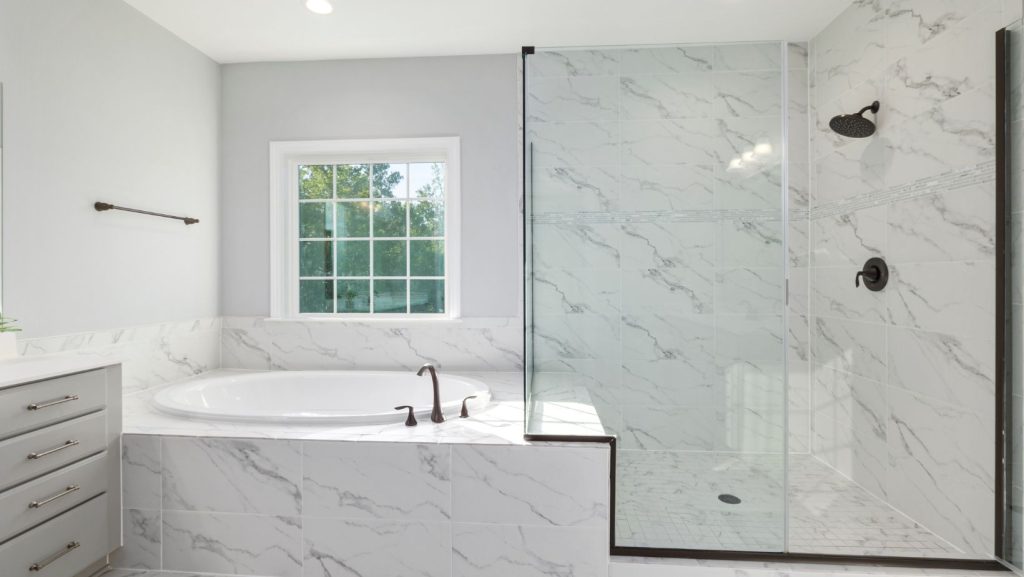
If you’re currently planning to remodel your bathroom or are in the market for a new home, you might be uncertain about which design you would prefer for your main or ensuite bathroom.
The ‘shower enclosure vs bathtub’ debate has endured for decades since the introduction of household showers, which started to become popular in the UK from the 1960s onwards.
With the advancement of contemporary designs and prioritization of convenience – not to mention limited space in many buildings – traditional bath basins for full-body soaking are increasingly being replaced with modern showers for faster washing while standing.
However, not everyone is so quick to dismiss the option of bathing while sitting or lying down in favor of standing showers only.
As it will significantly impact the layout and final look of the bathroom, plus your budget, your choice of shower or tub should align with your lifestyle and the space you’re working with.
Not sure exactly what to look for? Keep reading to discover the advantages and disadvantages of each type so you can decide which one fits your bathroom needs best.
Shower vs. Bath Considerations
Each has its own pros and cons, so choosing between a walk-in shower and a bathtub can be a difficult decision – but to make an informed one, you must consider a range of factors.
Here is a helpful list of things to think about when deciding on your ideal bathroom fixtures.
Available Space
Assuming there isn’t enough space for separate bath and shower units, or you don’t want both, the amount of space that you do have will be a major influence in choosing between them.
Walk-in showers typically have a smaller footprint than bathtubs, though they do occupy more space vertically. Shower enclosures are often better for smaller bathrooms because they’re easier to customize and can be very compact, especially if fitted in a corner.
Bathtubs take up valuable horizontal floor space – particularly freestanding baths, which are more suited to larger bathrooms. In more cramped quarters, baths that are long enough to recline in comfortably may reduce storage capacity and elbow room.
Accessibility
In addition to size limitations, the access needs of the people who will be using the bathroom are also critical factors that should guide your choice of shower or bath design.
For example, showers are generally considered more accessible for those with mobility issues, as it’s easier to get into a shower enclosure than to climb over the side of the bath – but shower trays can also be a trip hazard, and not everyone can stand and balance safely.
On the other hand, baths may be more convenient for families with small children – and bathtimes can also be an important part of child development. In either case, both showers and baths can be made safer with features like non-slip floors, seats, and grab bars.
Aesthetic Appeal
Functionality is paramount, but style matters, too. There’s no denying that shower enclosures lend themselves best to sleek modern bathrooms, while for bathtubs, there is a greater range from simple and contemporary to extravagant vintage designs.
That’s not to say you can’t dress up a shower if you have the budget, as there are plenty of different tray and tile choices in addition to lots of shower hardware styles. Plus a variety of functions, from rainfall showers to horizontal jets, and smart digital showers.
Bathtubs offer a wider selection of sculptural shapes and materials to suit almost any aesthetic, providing a timeless appeal that suggests greater luxury than a gleaming chrome showerhead. Of course, they can be modernized, too, with jets, whirlpools, and temperature controls.
Lifestyle Preferences
Your personal hygiene routine and everyday lifestyle will also influence your preference for either quick showers or leisurely baths (though long showers are also possible).
Busy people with fast-paced lives are more likely to need fast showers in their bathrooms – and even in guest bathrooms, visitors are unlikely to take a long soak in someone else’s house. So, on the surface, this fixture is more for necessity than self-care.
Baths, on the other hand, have long been associated with indulgent relaxation and the associated health benefits. Though less calming, baths are also more practical for bathing young children and even pets, which can be a messy endeavor.
Rest & Relaxation
To expand on the previous point, if R&R is important to you, then a bathtub you can properly decompress in will probably serve you better than a walk-in shower.
From luxuriating in warm water that helps you unwind to adding oils and other ingredients that can soften skin and soothe sore muscles, hot baths are excellent for alleviating physical tension and emotional stress at the end of a long day or strenuous week.
Standing in a hot shower can also offer therapeutic benefits, from steaming the sinuses to stimulating blood circulation with pressurized water. However, for a shower to be invigorating, you would need to spend longer under the running water (therefore spending more money).
Water Efficiency
Given the rising cost of energy and awareness around reducing water consumption, you may be looking for the most environmentally friendly option that can also keep your bills down.
In this case, a shower could be the most economical investment, as quick showers use much less water than filling up a bathtub. However, if you’re the type of person who prefers to take long showers, you might not save much on water usage.
If energy and water efficiency are important to you, new smart technologies can help by automatically adjusting temperature, flow, and water levels to reduce wastage, though they can be costly. Bathwater can also be recycled – for example, watering the garden.
Maintenance Level
Whether you go with a bath or a shower, both can last for many years, but they will also both need regular maintenance to keep them looking good and functioning properly.
Depending on the materials, size, and depth of the tub, baths can accumulate grime and dust at a faster pace, which can take more effort to clean. Enamel and ceramics also run a higher risk of chipping or cracking if you don’t take extra care with cleaning.
Showers can also accumulate water stains and soap deposits quickly, but their flat surfaces with non-porous materials tend to be much easier to wipe clean. Of course, seals and caulking will wear down over time and need replacing to prevent leakage and mildew.
Resale Value
When done well, a remodeled bathroom with either a bath or shower can add value to the property, helping to offset upfront costs if you plan to resell in the near future.
An argument can be made that most homebuyers these days lead busy modern lives, relying on quick and convenient showers. However, this could also be a reason for homebuyers wanting the option of a relaxing bath to make the most of their leisure time.
It’s also more likely that first-time homebuyers have young families or family planning in mind, and baths are better for children. On the other hand, buyers without children might prefer more modern and accessible washing facilities than just a tub.
A ‘full bath’ – with a toilet, sink, bath, and shower – would therefore add the most value over bathrooms with fewer fixtures.
Installation Costs
With all the above in mind, you need to calculate what your maximum budget will allow in terms of upfront costs, including the materials and labor required for your preferred design.
Being larger, bathtubs are often more expensive than showers, depending on how lavish they are. That said, despite the basic components typically being cheaper to acquire, showers are more complicated to install – especially digital ones – driving their overall cost up.
As with most major purchases, the less you spend, the less you’ll get. If you want premium looks and high-end functions, or to customize standard materials to suit your specific needs, the price tag will rise – but you’ll get more satisfaction from your investment in turn.
What About A Shower Bath?
In the end, choosing a bathtub or walk-in shower all comes down to user preference and what works best in terms of space, accessibility, hygiene, and comfort.
If you have weighed up all the points brought up throughout this blog and still can’t quite decide which fixture you would rather have, it might be better to simply meet in the middle.
Rather than choosing between a shower enclosure and a bathtub, a shower-bath combo allows you to add a shower above a bath and enjoy the best of both worlds.
You can complete the look with a glass screen on the side of the bath to keep splashes inside, or if you have a freestanding bath with a shower above it, installing full shower screens can help you to create an elegant bath-shower enclosure.
Whichever design you choose, as long as you plan it well to meet your specific needs, you can benefit from the perfect blend of aesthetics and practicality for years to come.














